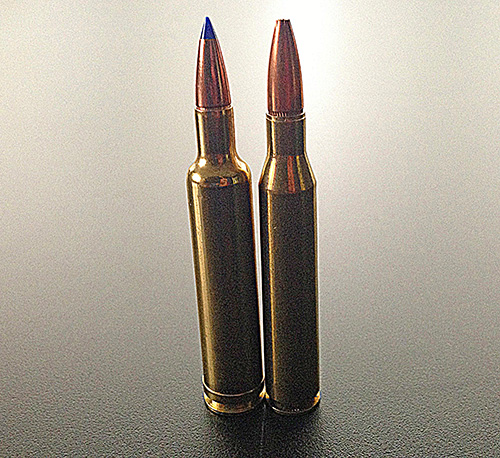
The .257 Wby. Mag. was introduced in 1944, and within Roy’s stable of hard-hitting, flat-shooting magnums, the .257 was his fair-haired favorite, which says a lot. Capable of driving an 80-grain bullet at 3,900 fps and a 100-grain bullet upwards of 3,600 fps, the Weatherby far outpaced the .257 Roberts, its main quarter-bore competition at the time.
Based on a shortened, necked-down .300 H&H case, the .257 Wby. Mag. has an impressive case capacity of about 85 grains. Roy liked speed and power, and the .257 Wby. Mag. offers plenty of both. It’s one of the flattest-shooting cartridges on the market, and Weatherby’s 110-grain Nosler AccuBond load travels at a muzzle velocity of 3,460 fps. It can be sighted in 2.7 inches high at 100 yards for a 300-yard zero, and at 400 yards the bullet has dropped less than eight inches.
The .257 Wby. Mag. has more recoil and muzzle blast and burns more powder than the .25-06 Rem., but it shoots extremely flat and hits extremely hard. For long shots on sheep, deer, antelope and African plains game, the .257 Wby. Mag. is a great choice, and there are several elk hunters who use the .257 Wby. Mag. regularly. Quarter-bores aren’t typically classed as elk rifles, but the load mentioned above generates almost 3,000 ft.-lbs. of energy at the muzzle and is still carrying 2,000 ft.-lbs. of punch beyond 200 yards, which is on par with a .30-06 with a 180-grain load. Rumor has it that Roy Weatherby killed a Cape buffalo with this .257 Wby. Mag. Point taken.
The venerable .30-06 Springfield wasn’t around very long before rifle cranks began necking the cartridge up and down, and as early as 1920 A.O. Neidner came up with the idea of necking the ’06 down to accept .257-inch bullets. He called the wildcat the .25 Neidner, but it wasn’t until 1969 that Remington commercialized the cartridge and changed its name to the .25-06 Rem. The cartridge was an instant success after it was introduced, even though the faster .257 Wby. Mag. had been around for 25 years.
What many shooters found was that the mighty Weatherby was just a bit more rifle than they needed for hunting deer. Besides, factory .25-06 ammo was cheaper, and handloaders could use .30-06 and .270 brass if they chose to do so. The venerable .25-06 found fans with outdoor writers such as Bob Milek, who spent a lot of time hunting the American West and considered the .25-06 the ultimate pronghorn cartridge.
Even though it isn’t as fast as the Weatherby, the .25-06 is no slouch. Most factory loads for the .25-06 drive a 100-grain bullet at about 3,200 fps, and 120-grain bullets are usually flying a little faster than 3,000 fps. Both of these loads deliver about 2,300 ft.-lbs. of energy at the muzzle, but at about 100 yards the energy drops below 2,000 ft.-lbs.
However, the .25-06 has plenty of energy for deer and antelope, and it shoots far enough and flat enough to make it a versatile hunting cartridge for medium-size game. When zeroed at 200 yards, the 100-grain bullet drops less than six inches at 300 yards and about 17 inches at 400 yards. That can’t beat the laser-flat trajectory of the .257 Wby. Mag., but the .25-06 is still a great choice for deer hunting on the open plains.
.25-06 Remington
Hits
- Will do 90% of what the Weatherby can do
- Brass, factory ammo widely available
- Better option for varmint/deer combo
Misses
- Not as versatile for big game
- .270 Win. is more popular with similar trajectory
- Lacks the panache of the Magnum moniker
.257 Weatherby Mag
Hits
- Power & speed make it very versatile
- Tolerable recoil for its capabilities
- Modern bullets can handle high speeds
Misses
- Expensive to shoot, limited ammo choices
- Lots of recoil and muzzle blast
- Burns 20% more powder than the avg. .25-06








